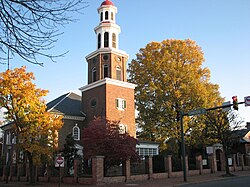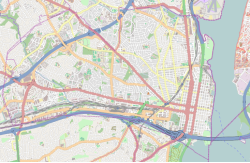Christ Church (Alexandria, Virginia)
|
Christ Church
|
|

Christ Church in Alexandria, Virginia
|
|
| Location | 118 North Washington Street, Alexandria, Virginia |
|---|---|
| Coordinates | 38°48′22.69″N 77°02′51.06″W / 38.8063028°N 77.0475167°WCoordinates: 38°48′22.69″N 77°02′51.06″W / 38.8063028°N 77.0475167°W |
| Built | Completed February 27, 1773 |
| Architect | James Wren |
| Architectural style | Georgian |
| NRHP Reference # | 70000899 |
| VLR # | 100-0012 |
| Significant dates | |
| Added to NRHP | May 10, 1970 |
| Designated NHL | April 15, 1970 |
| Designated VLR | September 18, 1973 |
Christ Church is a historic church and congregation at 118 North Washington Street in Alexandria, Virginia. It was completed in 1773 for an Episcopal in 1765, it is one of the least-altered of Virginia's few surviving colonial-era churches. The Georgian church was designed by James Wren, and frequented by such notables as George Washington, Robert E. Lee, and Philip Richard Fendall I. In addition, Franklin Roosevelt and Winston Churchill visited the church on January 1, 1942 to commemorate World Day of Prayer for Peace. Today, the church has over 2,400 members. It was declared a National Historic Landmark in 1970.
Christ Church is located in Alexandria's Old Town, at the southwest corner of North Washington and Cameron Streets. The brick two-story church measures about 60 feet (18 m) by 50 feet (15 m). Comparable to the less altered Pohick Church in the same parish, the church has been embellished with stone quoins and window surrounds. The roof is a simple hipped structure. A prominent tower was added between 1785 and 1815, as well as upper level galleries in the interior.
The Episcopal congregation that commissioned the church's construction was founded in 1765, when Fairfax Parish was established. The vestry commissioned the construction of two churches, this one, and another at Falls Church. The design of both buildings was by Colonel James Wren. Construction of this church was begun in 1767 by James Parson, but was not completed until 1773, under a new contract with John Carlyle. The church is distinctive among Virginia's colonial churches in that its interior was spared the ravages of the American Civil War and significant 19th-century restyling, and that its exterior is virtually unaltered except for the addition of the tower. Its organization also survived strong anti-Anglican sentiment during the American Revolution, and the church's disestablishment by the state.
...
Wikipedia





